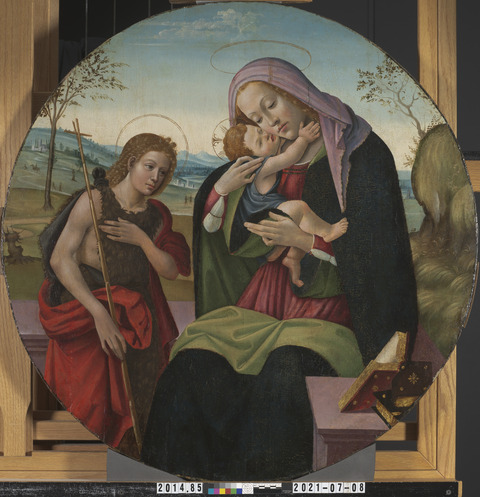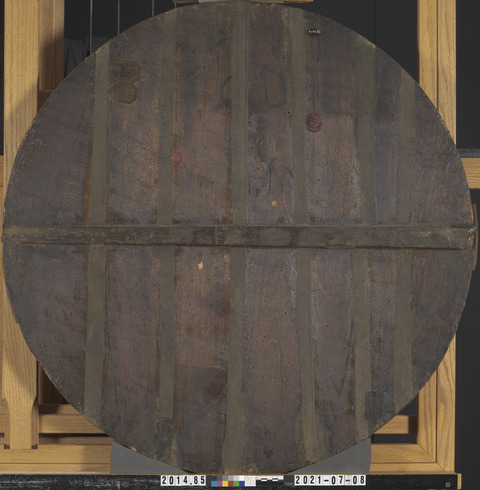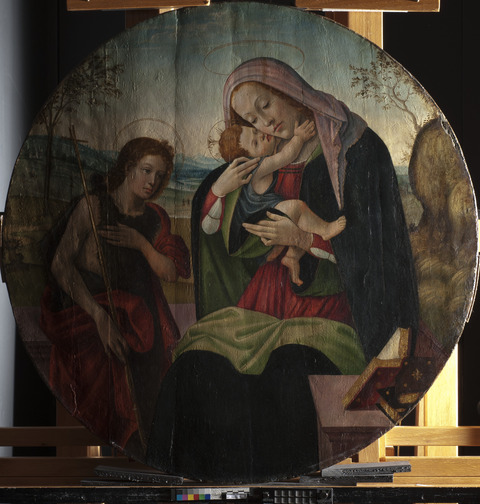Overview
Identification number: 2014.85
Artist: Circle of Sandro Botticelli (Master of the Campana Panels?)
Title: Madonna and Child with St. John the Baptist
Date of creation: About 1500
Previous number/accession number: C10029
Dimensions: 71 × 86 cm (varies slightly)
Conservator/examiner: Roxane Sperber with contributions from Fiona Beckett
Examination completed: 2014, revised 2021
Distinguishing Marks:
Front:
None
Back:
Item 1. Abraded red circular seal, back, upper half of the tondo, third plank from the right, “DOGANA DI MILANO” surrounding a crest
Item 2. Red circular seal, back, upper half of the tondo, third plank from the left (tech. fig. 2)
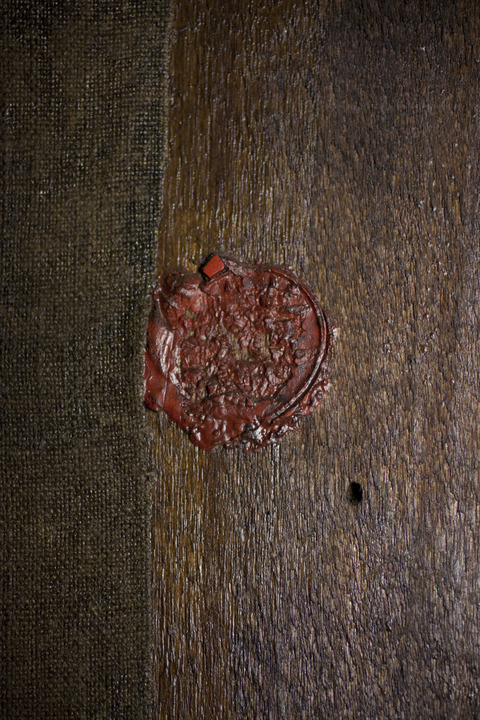
Item 3. Illegible label, back, upper-left area of panel, “…GES…H.M….”
Summary of Treatment History
The painting was thoroughly examined in 1939 by George Stout, which included a detailed description, and samples taken and analyzed. The painting was also previously cleaned several times, including partial varnish removal, as consistent with George Stout’s analysis.
Documentation suggests a series of condition assessments and treatments were carried out on the collection about the time the works were moved from the Clowes residence to the IMA in 1971. A condition report by Paul Spheeris in October of that year, likely carried out before the paintings were relocated, described the painting as not in need of treatment, although some lifting was noted on the frame.1
A second condition assessment was carried out upon arrival of the paintings at the IMA. This assessment described the work as being in good condition, and no work was deemed necessary.2 In 1996, a memorandum was written summarizing treatment and examination of the Clowes Collection since the time it entered the museum. This document noted that the painting underwent a minor treatment in 1981.3 This treatment included the setting down of flaking paint with gelatin and tissue paper, retouching of disturbed areas with matte Soluvar, inpainting with dry pigments in AYAB, spray varnish with Acryloid B-67 in xylene, a wax coating with Renaissance Wax, and reframing.
The painting underwent a full treatment in 2020/2021 that included varnish and retouching removal, application of a new varnish, and filling and inpainting losses.4
The condition of the painting was recorded in the Clowes Collection annual survey from 2011 to 2020.
Current Condition Summary
After the 2021 treatment, the painting is in a good aesthetic condition. The varnish is clear, and the inpainting is well matched. The treatment revealed a severely damaged paint layer, but there are many well preserved areas that the treatment also revealed. The painting is structurally sound, with previous structural interventions intact.
Methods of Examination, Imaging and Analysis
| Examination/Imaging | Analysis (no sample required) | Analysis (sample required) |
|---|---|---|
| Unaided eye | Dendrochronology | Microchemical analysis |
| Optical microscopy | Wood identification | Fiber ID |
| Incident light | Microchemical analysis | Cross-section sampling |
| Raking light | Thread count analysis | Dispersed pigment sample |
| Reflected/specular light | X-ray fluorescence spectroscopy (XRF) | Fourier-transform infrared spectroscopy (FTIR) |
| Transmitted light | Macro X-ray fluorescence scanning (MA-XRF) | Raman microspectroscopy |
| Ultraviolet-induced visible fluorescence (UV) | ||
| Infrared reflectography (IRR) | Gas chromatography–mass spectrometry (GC-MS) | |
| Infrared transmittography (IRT) | Scanning electron microscope -energy dispersive X-ray spectroscopy (SEM-EDS) | |
| Infrared luminescence | Other: | |
| X-radiography |
Technical Examination
Description of Support
Analyzed Observed
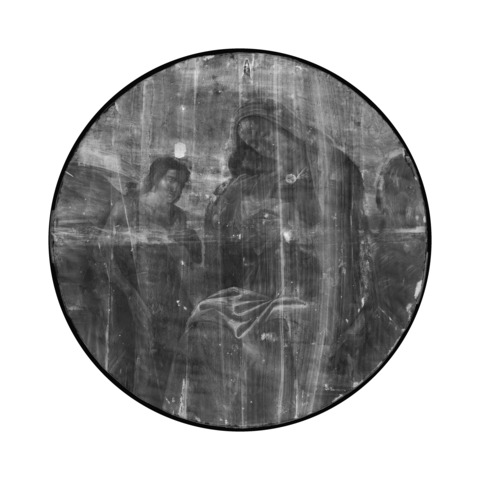
Material (fabric, wood, metal, dendrochronology results, fiber ID information, etc.):
The painting is executed on a wood panel with vertical grain and all members cut in slightly varying tangential orientations (tech. fig. 5).5 Three of the planks were sampled for wood identification, and all were identified as willow/poplar (Salicaceae spp.).6
Characteristics of Construction / Fabrication (cusping, beveled edges of panels, seams, joins, battens):
The panel is constructed from seven vertically oriented planks that are butt-joined with glue. Strips of canvas were applied over the joints on the back to reinforce them. The back of the panel shows marks consistent with hand-tooling. The edges of the panel are not beveled. There are a few small knots in the wood that are visible from the back of the panels.
The panel has a cross-batten attached via a dove-tailed slot. The batten was likely part of the original construction of the panel (tech. fig. 6). This is consistent with late fifteenth- and early sixteenth-century Italian constructions where dovetailed cross-battens were often used.7
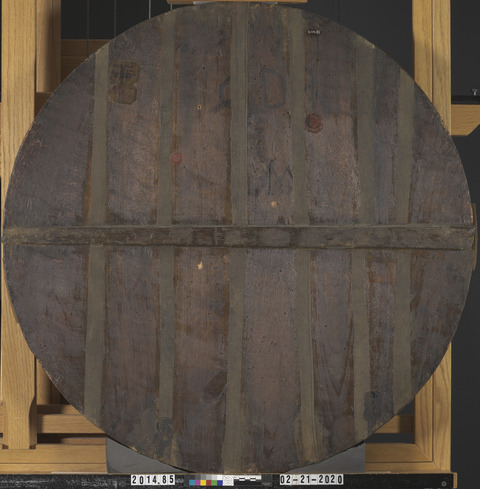
Thickness (for panels or boards):
Approximately 2.5 cm thick (~3.5 cm with batten)
Production/Dealer’s Marks:
Two red seals are visible on back (see Distinguishing Marks)
Auxiliary Support:
Original Not original Not able to discern None
Condition of Support
The panel is currently in stable condition and remains relatively in plane with a slightly convex warp. Some insect channeling is visible from the back as well as in the X-radiograph. The panel maintains its original thickness. There is slight wear along all edges of the panel.
Description of Ground
Analyzed Observed
Materials/Binding Medium:
The ground layer is composed of two layers of calcium sulfate (gesso). The ground layer was first analyzed in Stout’s 1939 analysis and found to be anhydrous calcium sulphate, a composition typical of fifteenth- and sixteenth-century Italian panel paintings.8 The calcium sulphate ground was confirmed during the 2021 treatment with EDS analysis (tech. figs. 9, 10).
Color:
The ground appears as an off-white color, slightly yellowed over time.
Application:
The ground was applied in two layers, likely with a large brush. The layers are separated by what appears to be a glue size layer (tech. fig. 7, layer 2). SEM of the cross section reveals the first layer to be quite similar in texture to the second layer, suggesting a system of applying a gesso grosso and gesso sottile was not used. Rather, the same gesso was used in both layers with a layer of glue in between.

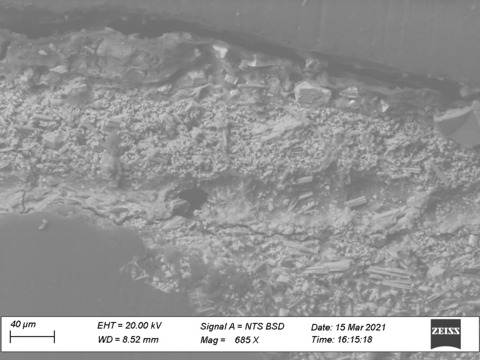
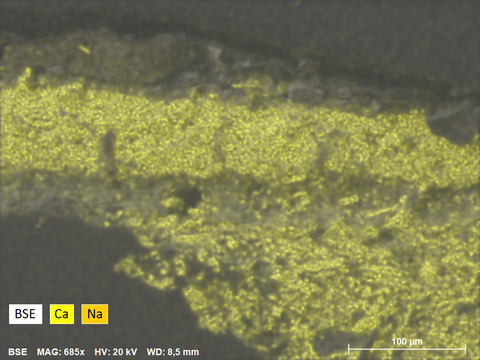
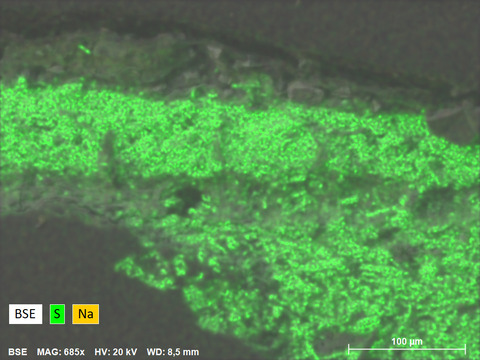
Thickness:
The gesso is approximately 200 µm thick. The first layer of gesso (layer 1) is approximately 100 µm thick and the second layer of gesso (layer 3) is approximately 100 µm thick (see tech. fig. 8).
Sizing:
Animal-glue size was applied to the panel before the application of the ground layer and a slightly yellowed area of the cross section is visible at the bottom. A second layer of size was applied in between layer of ground (layer 2).
Character and Appearance (Does texture of support remain detectable / prominent?):
The wood grain remains slightly visible through the ground and paint layers when viewed in raking light.
Condition of Ground
The ground is in stable condition. There is a network of age craquelure over the surface of the paint layer that is consistent with the wooden support. Losses are present around the wood joins and the edges. These have been filled and retouched. However, much of the damage to the paint layer does not extend to the ground.
Description of Composition Planning
Methods of Analysis:
Surface observation (unaided or with magnification)
Infrared reflectography (IRR)
X-radiography
Analysis Parameters:
| X-radiography equipment | GE Inspection Technologies Type: ERESCO 200MFR 3.1, Tube S/N: MIR 201E 58-2812, EN 12543: 1.0mm, Filter: 0.8mm Be + 2mm Al |
|---|---|
| KV: | 20 |
| mA: | 3.0 |
| Exposure time (s) | 150 |
| Distance from X-ray tube: | 36″ |
| IRR equipment and wavelength | Opus Instruments Osiris A1 infrared camera with InGaAs array detector operating at a wavelength of 0.9–1.7µm. |
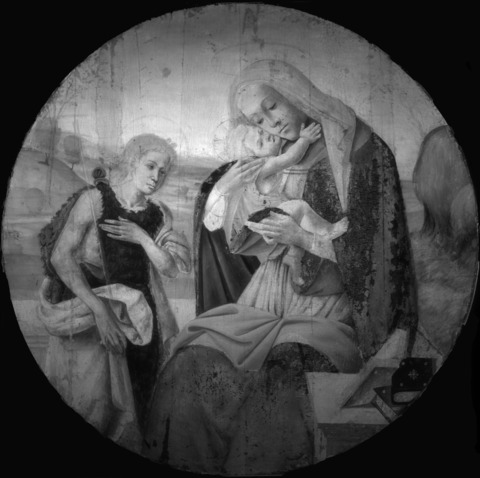
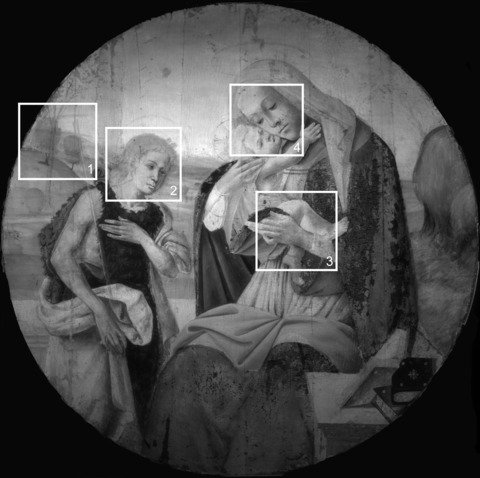
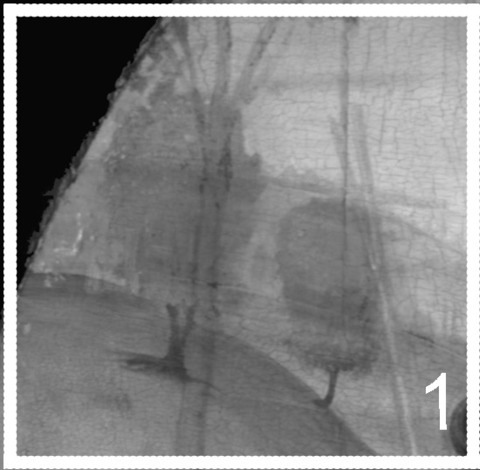
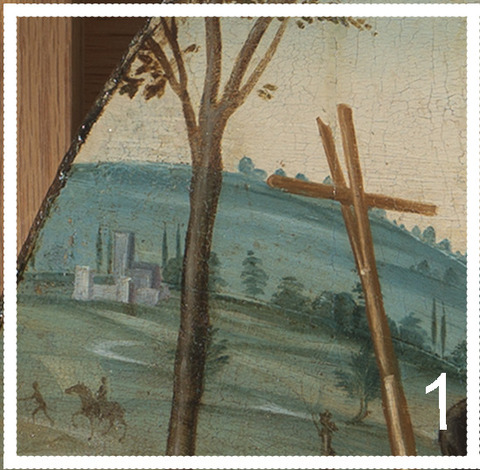
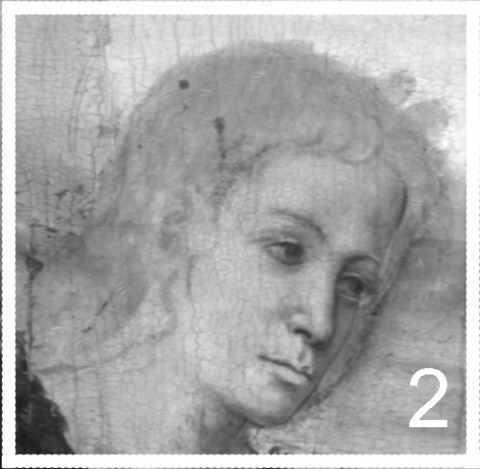
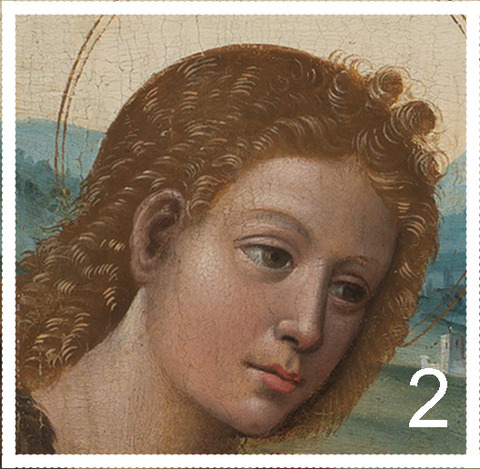
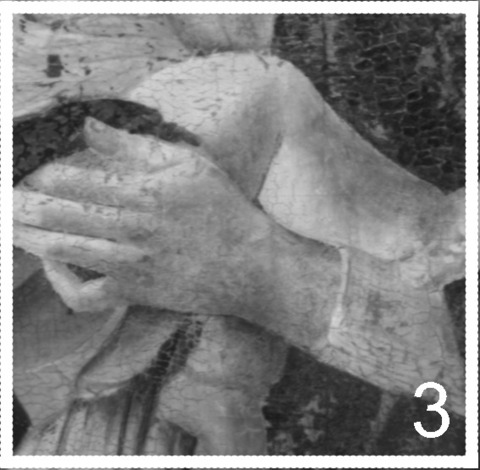
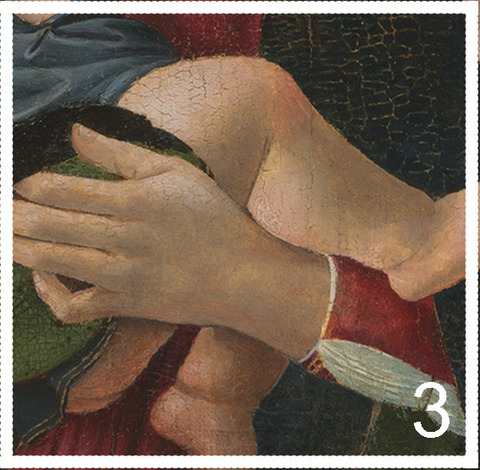
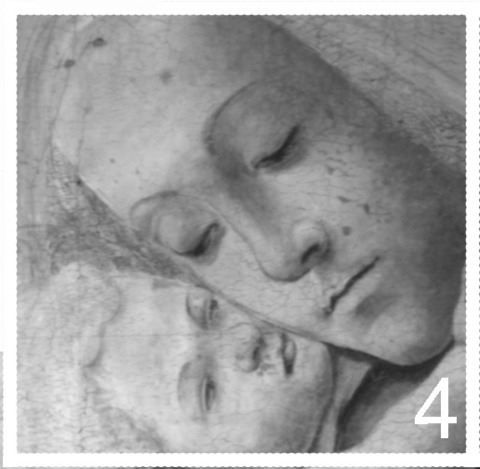
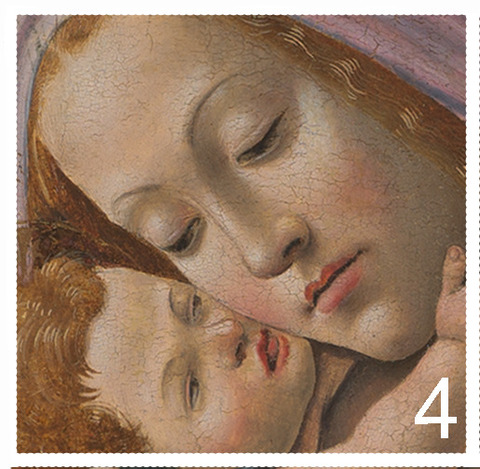
Medium/Technique:
Liquid medium, possibly ink
Underdrawing is visible in the infrared reflectogram (tech. fig. 11) and in areas of abraded paint that were visible during treatment when inpainting was removed (see tech. fig. 20). In some areas, such as the figure of St. John and the trees, the underdrawing has been applied with a brush using a wet medium and seems to have been painted freehand (tech. figs. 12, 14).
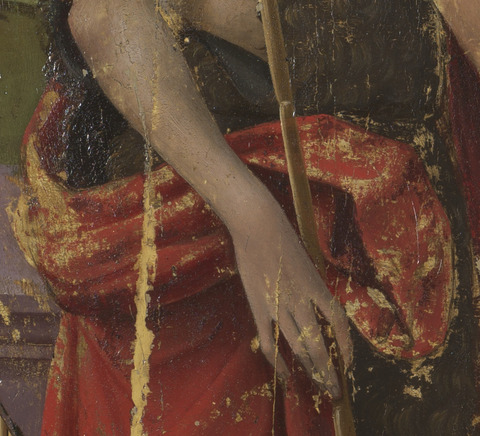
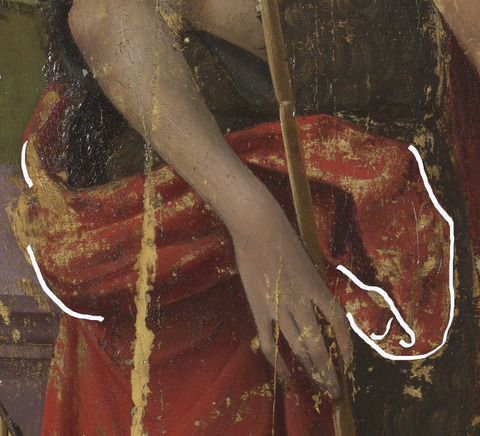
In the figures of the Madonna and Christ child, underdrawing appears as bolder lines around the contours of the figures (tech. figs. 16–19). These lines are more hesitantly articulated, suggesting they may have been traced. Given that an identical composition of the Christ child and Madonna appears on a tondo that is now in the São Paulo Museum of Art, it is likely that this area of the composition was traced from a cartoon.
Pentimenti:
The figure of St. John the Baptist has significant underdrawing in the face, where adjustments and changes have altered the size and placement of features. For example, the face was enlarged and rounded, and the placement of the eye was adjusted to reflect the new dimensions (tech. figs. 14, 15). The hairline was initially drawn further into the face with loose brushstrokes. Additionally, some of the landscape elements of the painting have been adjusted. For example, larger, rounder trees were initially painted to the left of St. John’s head and later removed from the composition during the painting phase (tech. figs. 12, 13).
Description of Paint
Analyzed Observed
Application and Technique:
The painting technique exemplifies that of a period of transition from egg tempera to oil paint. Although binding media was not confirmed using analysis, the technique suggests the work contains both egg and oil.
The paint was applied over the planned composition. The sky was painted first with rough reserves for the figures of St. John and the Madonna. The X-radiograph shows that the horizon line was originally lower and a slightly different shape with a steeper hill on the left side of the painting. The mountains in the distance were painted over the sky in shades of blue, transitioning to the greens in the middle ground and foreground.
The robes were painted using large, sweeping brushstrokes and blending that is suggestive of an oil medium. Form in the drapery was created using three tones: highlights, midtones, and shadows that were blended to created seamless transitions of form. In some areas, such as St. John’s red robe and the green lining of the Madonna’s green robe, glazes were used in the shadows. The midtone for each area of drapery was laid in separately with little overlap of the colors (tech. fig. 21). In the robes of the baby, however, individual strokes are visible in the highlights, and less blending is present. This technique is more suggestive of that of medieval Italian artists who worked in egg tempera.
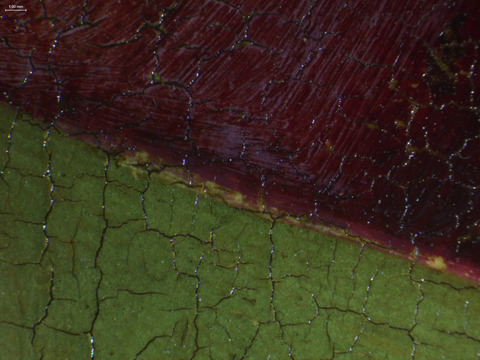
The flesh painting is carried out in long, linear brushstrokes using a much smaller brush (tech. fig. 22). Form is created through the application of warm pink midtones over which bright white highlights are applied. Cool gray and deep red shadows are applied in the deepest areas of shadows (tech. fig. 23). Unlike medieval Italian painters who applied a green or brown underlayer (verdaccio) to create the areas of shadow, the artist of this painting mixed and applied the shadows directly (tech. fig. 24). Similar to egg tempera technique, however, small, distinct brushstrokes are visible with very little blending. The application of light highlights over the dark shadows creates a cool transition from one area to another (tech. figs. 22–24).
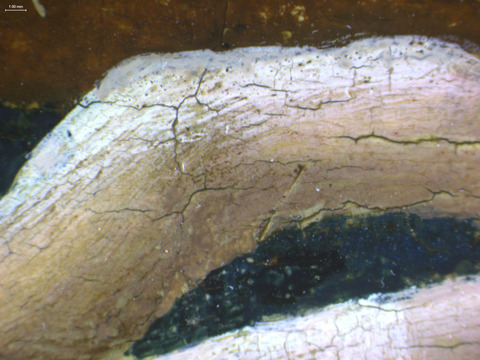

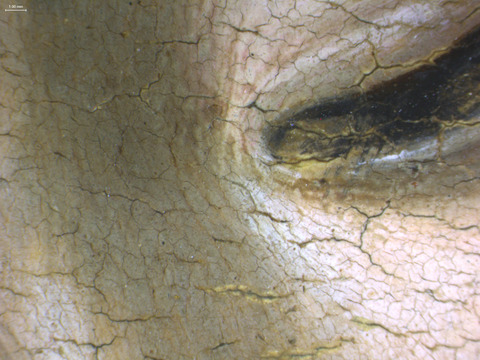
Details, including trees, distant figures, and St. John’s staff, were painted last. Glazes were used to paint the foliage in the background. Shell gold was also applied as decoration in the book, halos, and along the edges of the robes (tech. figs. 25, 26).
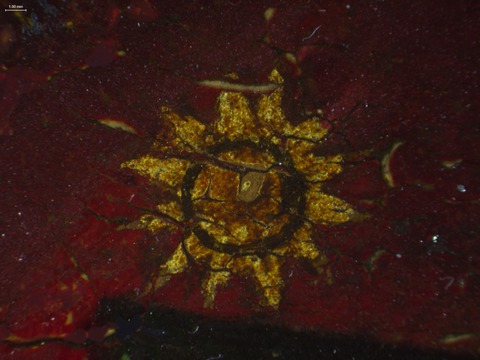
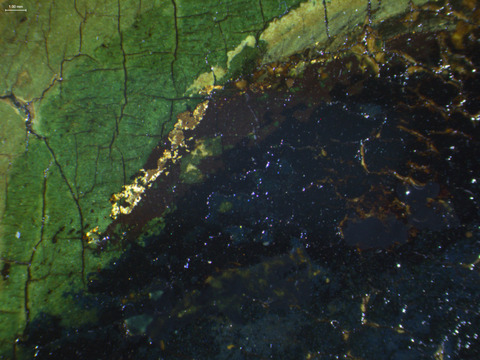
Painting Tools:
Brushes of varying sizes; no evidence of palette knife or other hard-edged tools. Gold leaf and shell gold paint applied in the uppermost layers.
Binding Media:
Oil (untested)
Color Palette:
The pigments as analyzed by XRF elemental analysis (tech. fig. 27) correspond with those recorded in technical examinations of works by Botticelli and with fifteenth-century Florentine painting. Lead white and azurite were used for the sky and background (the presence of copper in these areas are possibly a result of glazes of other copper-containing pigments, such as verdigris, and malachite used for the foliage) and are consistent with that used in Botticelli works, including La Primavera, although these are by no means unusual for the period.9 Lead-tin yellow was used in several areas of the painting, including the light green of the Madonna’s cloak, the gold area of the prayer book, and in the halos.10 The presence of mercury in some areas (skin and traces in halo, background) indicates limited use of vermilion, perhaps due to cost. The red pigments in the robes of St. John the Baptist and the Madonna figure were likely a combination of red lead, earths, and organic lakes. Gold leaf was used in the prayer book and appears to be oil gilding.
XFR Analysis:
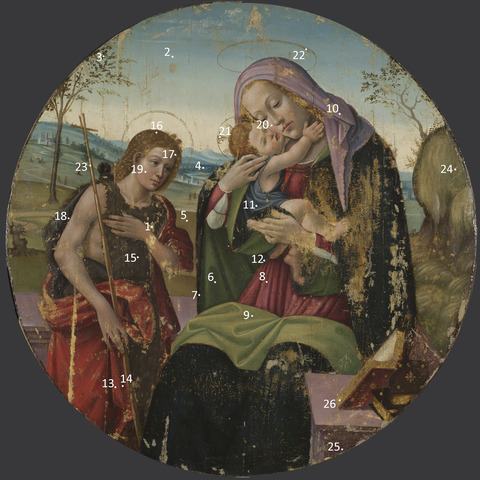
| Sample | Location | Elements | Possible Pigments |
|---|---|---|---|
| 1 | Ground layer | Major: Ca, S Minor: Trace: Pb, Fe, Sr | Calcium sulfate ground, trace of lead white, trace of iron oxide (earth pigments). |
| 2 | Sky | Major: Cu, Ca, Pb Minor: Fe Trace: | Azurite, lead white, iron oxide (earth pigments), calcium (from ground layer). |
| 3 | Tree leaf | Major: Cu, Pb Minor: Trace: Ca, Fe, Sn | Copper-containing green and/or blue pigment, lead white, lead-tin yellow, trace of calcium (from ground layer), trace of iron oxide (earth pigments). |
| 4 | Blue middle ground | Major: Cu, Pb Minor: Fe Trace: Ca | Azurite, lead white, iron oxide (earth pigments), trace of calcium (from ground layer). |
| 5 | Green foreground | Major: Cu, Pb, Fe Minor: Sn Trace: Ca, Ti | Copper-containing green and/or blue pigment, lead white, iron oxide (earth pigments), lead-tin yellow, trace of calcium (from ground layer). |
| 6 | Madonna’s green robe lining | Major: Cu, Pb Minor: Trace: Fe, Ca | Copper-containing green and/or blue pigment, lead white, calcium (from ground layer), trace of iron oxide (earth pigments), lead-tin yellow. |
| 7 | Madonna’s blue robe | Major: Pb, Cu Minor: Fe, Ca Trace: K, Ti | Azurite, lead white, iron oxide (earth pigments), calcium (from ground layer). |
| 8 | Madonna’s red dress | Major: Pb Minor: Ca, Fe Trace: Cu, K | Likely red lake pigments (cannot be confirmed with XRF), lead white, trace of copper-containing green and/or blue pigment, iron oxide (earth pigments), calcium (from ground layer). |
| 9 | Madonna’s light green blanket | Major: Cu, Pb Minor: Sn Trace: | Copper-containing green and/or blue pigment, lead white, lead-tin yellow. |
| 10 | Madonna’s headdress | Major: Pb, Cu Minor: Ca, Fe Trace: K | Lead white, azurite, likely red lake pigments, iron oxide (earth pigments), calcium (from ground layer). |
| 11 | Jesus’s robe | Major: Cu, Pb Minor: Fe Trace: Ca, Ti | Azurite, lead white, iron oxide (earth pigments), trace of calcium (from ground layer). |
| 12 | Gilding on Jesus’s robe | Major: Cu, Pb Minor: Fe, Au Trace: Ca, Ti | Azurite, lead white, gold leaf, iron oxide (earth pigments), trace of calcium (from ground layer). |
| 13 | John the Baptist’s red robe highlight | Major: Hg Minor: Ca Trace: Fe, Mn | Vermilion, calcium (from ground layer), trace of iron oxide (earth pigments). |
| 14 | John the Baptist’s red robe shadow | Major: Hg Minor: Ca Trace: Fe, Mn | Vermilion, likely red lake pigments (cannot be confirmed with XRF), calcium (from ground layer), trace of iron oxide (earth pigments). |
| 15 | John the Baptist’s hair shirt | Major: Pb, Hg, Fe Minor: Ca, Cu Trace: Ti, Mn | Vermilion, iron oxide (earth pigments), calcium (from ground layer), copper-containing green and/or blue pigment. |
| 16 | John the Baptist’s hair shadow | Major: Pb, Fe Minor: Trace: Ca, Cu, Ti, Hg, K | Lead white, iron oxide (earth pigments likely yellow ocher), trace of calcium (from ground layer), trace of copper-containing green and/or blue pigment, trace of vermilion. |
| 17 | John the Baptist’s hair highlight | Major: Pb, Fe Minor: Trace: Ca, Cu, K, Zn | Lead white, iron oxide (earth pigments likely yellow ocher), trace of calcium (from ground layer), trace of copper-containing green and/or blue pigment. |
| 18 | Black robe | Major: Cu, Pb Minor: Ca Trace: Fe, Ti, K | Copper-containing green and/or blue pigment, lead white, possible carbon black, trace of iron oxide (earth pigments), calcium (from ground layer). |
| 19 | John the Baptist’s skin | Major: Pb Minor: Hg Trace: Fe, Ca | Lead white, vermilion, trace of iron oxide (earth pigments), trace of calcium (from ground layer). |
| 20 | Madonna’s cheek | Major: Pb Minor: Hg Trace: Fe, Ca | Lead white, vermilion, trace of iron oxide (earth pigments), trace of calcium (from ground layer). |
| 21 | Jesus’s halo | Major: Cu, Pb, Fe Minor: Zn Trace: Ca | Bronze restoration paint?, azurite, lead white, iron oxide (earth pigments), trace of calcium (from ground layer). |
| 22 | Madonna’s halo | Major: Cu, Pb, Fe Minor: Au Trace: Ca | Gold leaf, azurite, lead white, iron oxide (earth pigments), trace of calcium (from ground layer). |
| 23 | John the Baptist’s staff highlight | Major: Pb, Fe Minor: Cu Trace: Ca | Lead white, iron oxide (earth pigments likely yellow ocher), copper-containing green and/or blue pigment, trace of calcium (from ground layer). |
| 24 | Yellow plant | Major: Pb Minor: Cu, Sn Trace: | Lead white and/or lead-tin yellow, copper-containing green and/or blue pigment. |
| 25 | Purple desk | Major: Pb, Cu, Fe Minor: Ca, Fe Trace: K | Iron oxide (earth pigments), lead white, copper-containing green and/or blue pigment, likely red lake pigments, calcium (from ground layer). |
Table 1: Results of X-ray fluorescence analysis conducted with a Bruker Artax microfocus XRF with rhodium tube, silicon-drift detector, and polycapillary focusing lens (~100μm spot).
*Major, minor, trace quantities are based on XRF signal strength not quantitative analysis.
Surface Appearance:
The paint appears to be relatively thinly applied, with no areas of impasto, although the brushwork and defining lines are slightly raised.
Condition of Paint
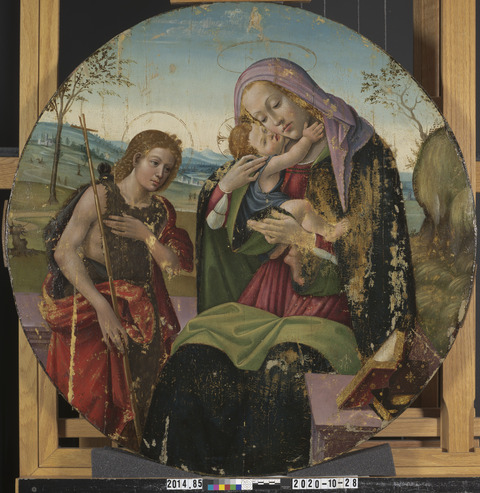
A photograph from the 2021 treatment showing the condition of the paint layer after varnish removal and before inpainting shows the condition of the original paint layer (tech. fig. 28). Many areas of glazing, as well as large areas of the Madonna’s cloak, the Madonna’s left hand, the Christ child’s right foot, and St. John’s cloak, had been heavily abraded from a previously invasive cleaning. Other losses are present along the joins in the panels and the sky, and there are small losses across the panel. Degradation in the Madonna’s blue robe has led to flattening of this area (tech. fig. 29).
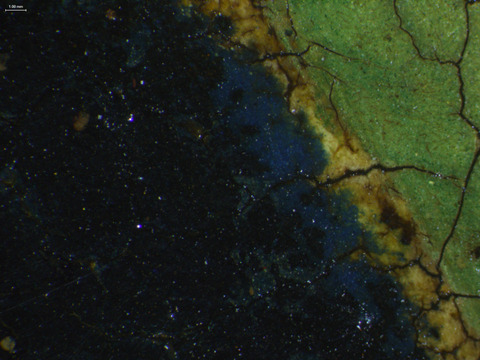
Description of Varnish/Surface Coating
Analyzed Observed Documented
| Type of Varnish | Application |
|---|---|
| Natural resin | Spray applied |
| Synthetic resin/other | Brush applied |
| Multiple Layers observed | Undetermined |
| No coating detected |
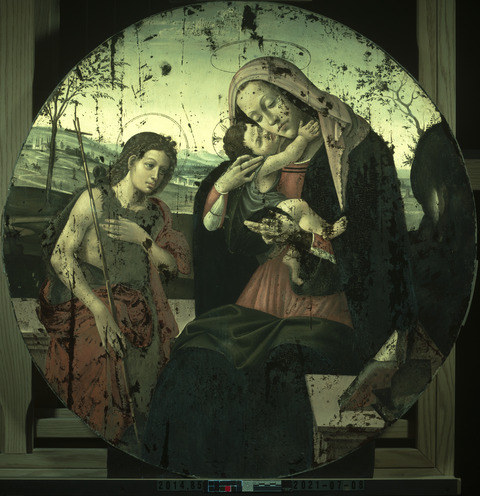
The report from the 2021 treatment records that several layers of synthetic varnish composed of a blend of Paraloid B-72 (20%) and Larapol A81 (80%) dissolved in Shellsol A100 were brush applied to the surface to saturate the dark robe of the Madonna. A final coat of 30% Larapol A81 in Shellsol A100 was applied over the layers once the darks were saturated. The painting does not fluoresce strongly in ultraviolet-induced visible fluorescence due to the presence of synthetic varnish. However, extensive inpainting can been identified in the ultraviolet-induced visible fluorescence photograph (tech. fig. 30). The inpainting was applied using Gamblin Conservation Colors in 30% Larapol A81 in Shellsol A100. A final spray varnish of 20% Larapol A81 in Shellsol A100 was applied.11
Condition of Varnish/Surface Coating
The varnish is clear and well saturated. The varnish is slightly glossy, which was necessary to achieve a fully saturated coating. The inpainting is saturated and well matched.
Description of Frame
Original/first frame
Period frame
Authenticity cannot be determined at this time/ further art historical research necessary
Reproduction frame (fabricated in the style of)
Replica frame (copy of an existing period frame)
Modern frame
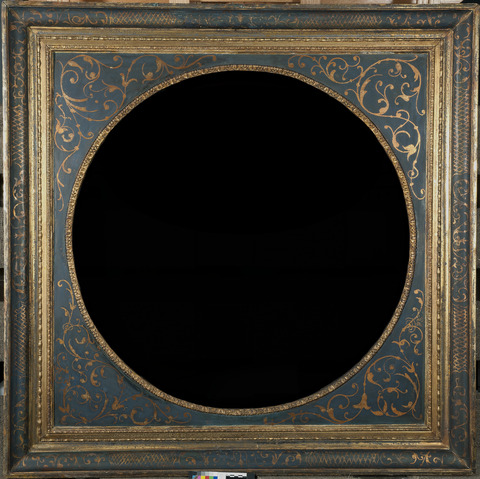
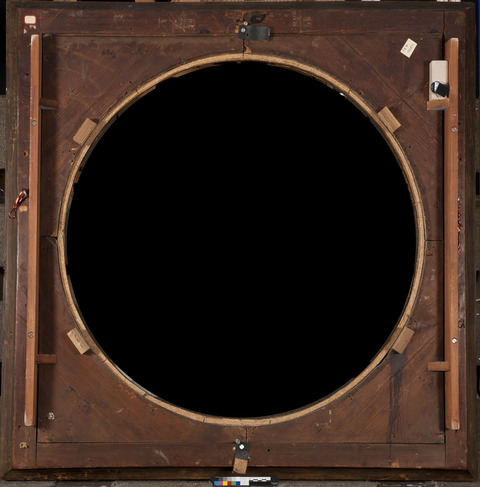
Frame Dimensions:
Outside frame dimensions: 114 × 114 cm
Sight size: 84 × 84 cm
Distinguishing Marks:
Item 4. Paper label, handwriting in purple ink, upper-right corner, “T.R. 10029” (tech. fig. 32).
Item 5. Paper label with red border, handwriting in pencil, upper-left corner, “6734/23” (tech. fig. 33).
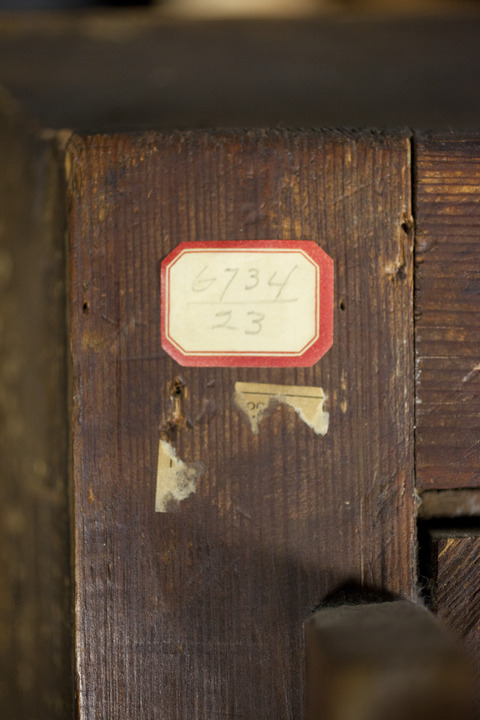
Item 6. Wood-burned inscription, upper-left corner, “GESǂ” (tech. fig. 34).
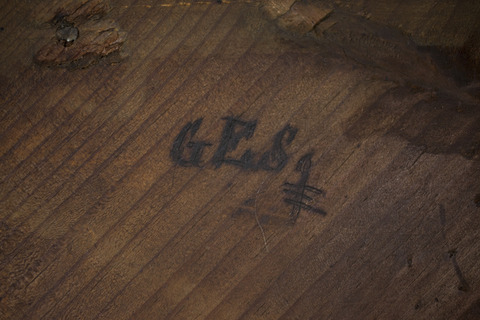
Item 7. Handwritten inscription, black ink, upper-left corner, “No. 735 Gaudenzio Ferrari/ …Milanese” (tech. fig. 35).

Item 8. Handwritten inscription in pencil, upper-left corner, “3~ 736” (tech. fig. 36).
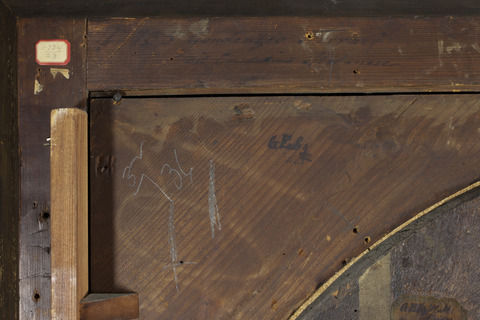
Description of Molding/Profile:
According to Timothy Newbery’s examination from 19 January 2012, the frame is a twentieth-century, Eastern European frame constructed from pine (possibly from about 1920). It is an empire-style frame repainted later, possibly to fit the tondo (tech. fig. 31). It has miter-lapped corners (tech. fig. 32) and includes acanthus leaf and shield, bead, and reel ornaments made from composition (compo). It is painted blue with orange and bronze paint for the decorative elements. There is also decoration on the spandrel and ogee.12

Condition of Frame
The frame is structurally stable after the 2021 consolidation but is in relatively poor aesthetic condition. It was damaged in the past and restored in the twentieth century using bronze and blue paint. The spandrel is also slighted warped. There have also been several poorly executed repairs to the molded composition (compo).
Notes
-
Paul A.J. Spheeris, “Conservation Report on the Condition of the Clowes Collection,” 25 October 1971, Conservation Department Files, Indianapolis Museum of Art at Newfields. ↩︎
-
Martin Radecki, Clowes Collection condition assessment, undated (after October 1971), Conservation Department Files, Indianapolis Museum of Art at Newfields. ↩︎
-
Memorandum from Martin Radecki to Bret Waller, “Conservation Work on Clowes Fund Collection,” 16 February 1996, Conservation Department Files, Indianapolis Museum of Art at Newfields. ↩︎
-
Roxane Sperber, CON2020.10: Examination, Treatment Proposal, and Treatment Report, 2020–2021, C10029 (2014.85), Conservation Department Files, Indianapolis Museum of Art at Newfields. ↩︎
-
Due to the slight convex warp of the panel, the images on the individual X-radiography plates haves been slightly distorted. This distortion makes it impossible to merge the X-radiographs without slightly morphing the image. Therefore, the appearance of the wood grain in the X-radiograph is not completely straight, and the horizonal batten appears slightly askew. ↩︎
-
Ian Tyers, “Tree-Ring Analysis and Wood Identification of Paintings from the Indianapolis Museum of Art: Dendrochronological Consultancy Report 1082,” January 2019, p. 32, Conservation Department files, Indianapolis Museum of Art at Newfields. ↩︎
-
Luca Uzielli, “Historical Overview of Panel-Making Techniques in Central Italy,” in The Structural Conservation of Panel Paintings: Proceedings of a Symposium at the J. Paul Getty Museum, 24-28 April 1995, ed. Dardes, Kathleen, and Andrea Rothe (Los Angeles, CA: Getty Conservation Institute, 1998), 122, 126, https://www.getty.edu/conservation/publications_resources/pdf_publications/pdf/panelpaintings2.pdf. ↩︎
-
Jill Dunkerton and Ashok Roy, “The Materials of a Group of Late Fifteenth-Century Florentine Panel Paintings,” National Gallery Technical Bulletin 17 (1996): 20–31, http://www.nationalgallery.org.uk/technical-bulletin/dunkerton_roy1996. ↩︎
-
http://www.palazzo-medici.it/mediateca/en/Scheda_La_Primavera_di_Sandro_Botticelli. ↩︎
-
Jill Dunkerton and Ashok Roy, “The Materials of a Group of Late Fifteenth-century Florentine Panel Paintings,” National Gallery Technical Bulletin 17 (1996). ↩︎
-
Roxane Sperber, CON2020.10: Examination, Treatment Proposal, and Treatment Report, 16 July 2021, C10029 (2014.85), Conservation Department Files, Indianapolis Museum of Art at Newfields. ↩︎
-
Timothy Newbery, frame specialist, London, England. Visual analysis completed at the Indianapolis Museum of Art, 19 January 2012. ↩︎
Additional Images
